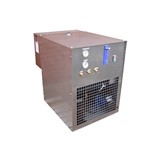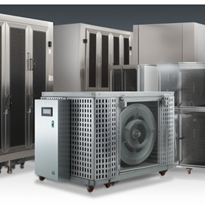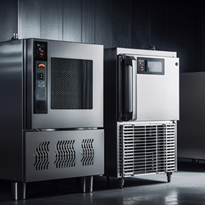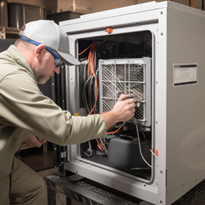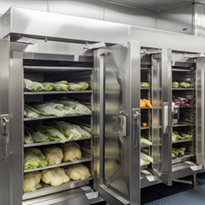Explore blast chiller prices and expert buying tips for Australian businesses. Learn how to choose the best unit for efficiency and reliability.
Key Takeaways:
- Blast Chillers are essential for quickly cooling food, maintaining its quality, and preventing bacteria growth.
- Types of Blast Chillers: Static Blast Chillers and Turbine (Forced Air) Blast Chillers are the two main types.
- Prices: Small units range from $3,000 to $8,000, while larger, more advanced models can cost between $8,000 and $25,000+.
- Operation: Blast chillers rapidly reduce the temperature of hot food, which helps preserve taste, texture, and nutritional value.
- Maintenance: Regular cleaning, defrosting, and service checks are necessary for longevity and efficiency.
- Financing Options: Available through equipment loans, leasing, and rent-to-own schemes.
- Compliance: All commercial blast chillers must meet Australian food safety and refrigeration standards.
- Warranties: Typically range from 1 to 5 years, with optional extended warranty options.
Introduction
For food service businesses, cafes, restaurants, and food manufacturers in Australia, blast chillers are vital for maintaining food quality while ensuring safety. By rapidly cooling food, blast chillers help prevent the growth of harmful bacteria and preserve the food’s texture, flavour, and shelf life. Whether you're storing freshly prepared meals, freezing desserts, or preparing large quantities of food, a blast chiller is indispensable in any professional kitchen or food processing environment.
In this comprehensive buying guide, we’ll help you understand how blast chillers work, explore pricing, guide you on maintenance, and provide essential information to help you make a well-informed purchasing decision tailored to your business needs.
What Is a Blast Chiller?
A blast chiller is a specialised refrigeration unit designed to rapidly cool hot food from cooking temperatures to below 3°C (or freeze it down to -18°C) in a short period. By cooling food quickly, it helps lock in moisture and prevents the growth of bacteria that can occur during slower cooling methods.
There are two main types of blast chillers:
1. Static Blast Chillers:
- Design: The food is cooled by surrounding cold air without forced circulation.
- Best For: Smaller operations or where food batches are smaller.
- Pros: Lower cost, simpler design.
- Cons: Slower cooling times.
2. Turbine (Forced Air) Blast Chillers:
- Design: Features a fan that circulates cold air around the food to chill it quickly.
- Best For: Larger operations with high-volume food production.
- Pros: Faster cooling, more efficient.
- Cons: Higher initial cost.
Key Factors to Consider When Buying a Blast Chiller
1. Size and Capacity
When purchasing a blast chiller, you need to consider how much food you need to chill at once. Sizes typically range from 3 to 40 trays or more.
- Small Units (3-10 trays): Best for small cafés or restaurants.
- Medium Units (10-20 trays): Suitable for medium-sized kitchens or food preparation areas.
- Large Units (30-40 trays): Ideal for high-volume kitchens, large restaurants, or food manufacturers.
2. Cooling Speed
Blast chillers are rated by how fast they can reduce the food’s temperature. There are two common cooling processes:
- Blast Cooling: Cools food from 70°C to 3°C in less than 90 minutes.
- Shock Freezing: Freezes food from 70°C to -18°C in around 4 hours.
Fast cooling speeds are crucial for maintaining food safety and quality, especially in high-volume operations.
3. Energy Efficiency
Look for energy-efficient models to reduce long-term running costs. Many newer blast chillers are designed to be energy-efficient while still offering high performance. Check for energy ratings or look for brands with energy-saving features.
4. Ease of Use and Features
Some additional features to consider include:
- Programmable Controls: Allows for precise control over temperature and cooling times.
- Defrosting Functions: Essential for preventing ice build-up.
- Stainless Steel Interiors: Easier to clean and more durable.
Blast Chiller Prices in Australia
Prices for blast chillers vary depending on the size, brand, and features of the unit. Here’s a general breakdown of typical prices:
- Small Units (3-5 trays):
- Price Range: $3,000 – $8,000
- Ideal for small operations such as cafés, small restaurants, and catering services.
- Medium Units (10-20 trays):
- Price Range: $8,000 – $15,000
- Best for medium-sized restaurants, kitchens, and food preparation areas.
- Large Units (30-40 trays):
- Price Range: $15,000 – $25,000+
- Suitable for large food manufacturing operations or high-volume restaurants.
How Does a Blast Chiller Work?
A blast chiller works by rapidly cooling hot food to safe temperatures. The process involves circulating cold air (or forced air) around the food at sub-zero temperatures. This rapid cooling process ensures that bacteria growth is minimised and that the food retains its freshness, texture, and flavour.
Step-by-Step Process:
- Place the food in the blast chiller, ensuring it’s evenly distributed.
- Cold air circulation: Cold air circulates around the food, rapidly lowering the temperature.
- Final temperature: Once the desired temperature is reached, the food is either stored in the chiller or transferred to a freezer.
Maintenance Tips for Blast Chillers
Proper maintenance ensures your blast chiller operates efficiently and lasts longer. Here are some essential maintenance tips:
- Clean the unit regularly: Remove food debris and clean the interior and exterior.
- Defrosting: Regularly defrost the unit to prevent ice build-up, which could reduce its efficiency.
- Check the refrigerant levels: Ensure the refrigerant is at optimal levels to maintain cooling performance.
- Service the compressor: Regular checks and maintenance to ensure optimal performance.
Compliance and Certification for Blast Chillers in Australia
In Australia, all commercial refrigeration equipment, including blast chillers, must comply with food safety regulations to ensure that food remains safe and free from contamination. The main compliance and certification standards are:
- Food Standards Australia New Zealand (FSANZ): Ensures compliance with food safety requirements.
- Australian Refrigeration Council (ARC): Certification required for refrigeration professionals who install and maintain chillers.
- AS/NZS 4674: This Australian Standard specifies requirements for food premises and equipment, including blast chillers.
Financing and Warranties
Financing Options
Buying a blast chiller outright can be a significant investment. Thankfully, there are financing options available to help you manage the cost:
- Equipment Loans: Available through banks or specialised equipment finance companies.
- Leasing: Many suppliers offer leasing options for blast chillers, which allows you to pay over a set term.
- Rent-to-Own: You can rent the equipment with an option to purchase it later.
Warranties
When purchasing a blast chiller, check the warranty details:
- Standard Warranties: Typically 1-5 years.
- Extended Warranties: Some manufacturers offer extended warranties for an additional cost.
Common Questions About Blast Chillers
1. What size blast chiller do I need?
The size of the unit depends on the volume of food you need to chill. Small kitchens may need a 3-5 tray unit, while high-volume operations may require larger models with 30-40 trays.
2. How long does a blast chiller take to cool food?
A blast chiller can cool food from 70°C to 3°C in around 90 minutes. Shock freezers can freeze food to -18°C in approximately 4 hours.
3. Are blast chillers energy-efficient?
Yes, many blast chillers are designed to be energy-efficient, especially modern models. Look for Energy Star rated units to reduce operating costs.
4. Are blast chillers required by law?
While not legally required, blast chillers are essential for complying with Australian food safety regulations and preventing foodborne illnesses.
5. How much maintenance does a blast chiller require?
Regular cleaning, defrosting, and annual servicing are essential for optimal performance.
Conclusion
Choosing the right blast chiller for your Australian business depends on several factors, such as size, capacity, and energy efficiency. Prices vary from $3,000 for smaller units to over $25,000 for high-capacity models. When purchasing, always consider the cooling speed, energy efficiency, and compliance with food safety standards. Make sure to factor in maintenance and service costs, as proper care will ensure your investment lasts for many years.
By following this guide, you can confidently purchase a blast chiller that meets your needs while ensuring the safety and quality of your food.



